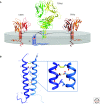Structural biology of the T-cell receptor: insights into receptor assembly, ligand recognition, and initiation of signaling
- PMID: 20452950
- PMCID: PMC2845206
- DOI: 10.1101/cshperspect.a005140
Structural biology of the T-cell receptor: insights into receptor assembly, ligand recognition, and initiation of signaling
Abstract
The T-cell receptor (TCR)-CD3 complex serves as a central paradigm for general principles of receptor assembly, ligand recognition, and signaling in the immune system. There is no other receptor system that matches the diversity of both receptor and ligand components. The recent expansion of the immunological structural database is beginning to identify key principles of MHC and peptide recognition. The multicomponent assembly of the TCR complex illustrates general principles used by many receptors in the immune system, which rely on basic and acidic transmembrane residues to guide assembly. The intrinsic binding of the cytoplasmic domains of the CD3epsilon and zeta chains to the inner leaflet of the plasma membrane represents a novel mechanism for control of receptor activation: Insertion of critical CD3epsilon tyrosines into the hydrophobic membrane core prevents their phosphorylation before receptor engagement.
Figures




References
-
- Adams EJ, Chien YH, Garcia KC 2005. Structure of a γδ T cell receptor in complex with the nonclassical MHC T22. Science 308:227–231 - PubMed
-
- Aivazian D, Stern LJ 2000. Phosphorylation of T cell receptor zeta is regulated by a lipid dependent folding transition. Nat Struct Biol 7:1023–1026 - PubMed
-
- Alcover A, Mariuzza RA, Ermonval M, Acuto O 1990. Lysine 271 in the transmembrane domain of the T-cell antigen receptor β chain is necessary for its assembly with the CD3 complex but not for α/β dimerization. J Biol Chem 265:4131–4135 - PubMed
Publication types
MeSH terms
Substances
Grants and funding
LinkOut - more resources
Full Text Sources
Other Literature Sources
Molecular Biology Databases
Research Materials
